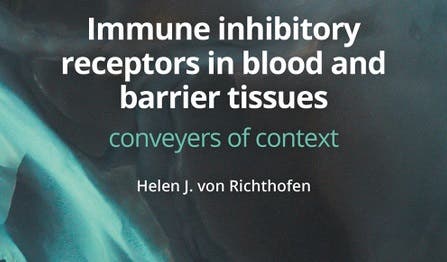Jun 28: Immune inhibitory receptors in blood and barrier tissues

Some inhibitory receptors, including SIRL-1, recognize patterns that indicate danger or safety on a (sub-)cellular level. In this way, inhibitory receptors can provide additional information to a cell about the context in which it is receiving other stimuli. The increasing understanding of inhibitor receptor biology may lead to improved therapeutic targeting of these receptors in diseases such as infection and cancer, concludes Helen von Richthofen (UMC Utrecht) in her PhD thesis.
The strength of the immune response needs to be tightly regulated: a too strong immune response damages healthy tissue, while a too weak immune response can lead to survival of pathogens or cancer cells. One of the ways by which the activity of the immune system is regulated is by the expression of inhibitory receptors. Inhibitory receptors dampen immune activation by blocking the signaling of activating immune receptors. It has been estimated that the human body has over 300 different inhibitory receptors of which the vast majority has not yet been investigated. PhD candidate Helen von Richthofen (Center for Translational Immunology, UMC Utrecht) describes in her thesis novel concepts related to the biology of several of these inhibitory receptors.
In the first part of this thesis, von Richthofen and her co-workers focused on one of these inhibitory receptors, named Signal Inhibitory Receptor on Leukocytes-1 (SIRL-1). They showed that SIRL-1 is differentially expressed on myeloid cell subsets in blood and barrier tissues. In addition, they identified endogenous ligands of SIRL-1, namely S100 proteins. These proteins are released upon tissue damage, and are therefore considered ‘danger-associated molecular patterns’ (DAMPs). The investigators propose that recognition of S100 proteins by SIRL-1 may dampen immune responses to limit tissue damage. They describe that SIRL-1 is also activated by phenol-soluble modulins (PSMs) from Staphylococci and by the endogenous cathelicidin LL-37. These ligands have structural and functional similarities, such as an amphipathic α-helical structure. Lastly, they showed that SIRL-1 is shed from activated neutrophils, resulting in the release of soluble SIRL-1. This can be prevented by the protease inhibitor Eap from S. aureus.
Prompted by the finding that SIRL-1 recognizes amphipathic alpha-helical patterns, Helen von Richthofen performed a literature study and described that several inhibitory receptors recognize molecular patterns related to danger or homeostasis. She proposes that these inhibitory pattern recognition receptors (iPRRs) provide environmental context to immune cells, thereby mediating appropriate responses to molecular patterns. Finally, she reviewed evidence for a regulatory role of inhibitory receptors on non-immune cells, focusing on epithelial and endothelial cells.
Helen von Richthofen summarizes her work: “Together, the findings in this thesis lead to improved understanding of inhibitory receptor biology, which may guide further research into the therapeutic targeting of these receptors in disease.”
PhD defense
Helen von Richthofen (1989, Berlin-Wilmersdorf, Germany) defended her PhD thesis on June 28, 2023 at Utrecht University. The title of her thesis was “Immune inhibitory receptors in blood and barrier tissues – conveyors of context.” Helen was granted an I&I Boost Grant in 2020 (together with Marcel de Zoete) to study whether inhibitory receptors regulate epithelial response to commensale microbes. In May 2023, Helen started working as a scientist at Neogene Therapeutics (Amsterdam) to develop T cell therapies against solid cancers.
